Physical Address
304 North Cardinal St.
Dorchester Center, MA 02124
Physical Address
304 North Cardinal St.
Dorchester Center, MA 02124
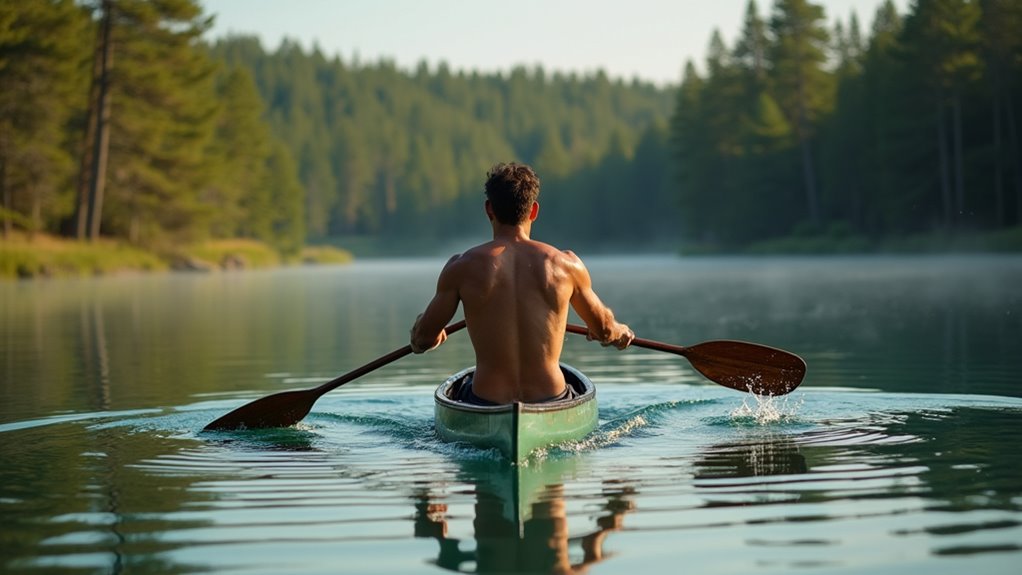
Just mastering these fundamental canoe paddling techniques will prevent you from becoming another capsizing statistic on the water.
Last summer, a novice paddler capsized within minutes of launching because he’d never learned proper stroke technique or how to read the water’s subtle warning signs. You might think canoeing is just about dipping your paddle and moving forward, but there’s actually a precise set of fundamentals that separate confident paddlers from those who struggle against every current. Master these essential techniques, and you’ll transform from someone who fights the water into someone who moves with it effortlessly.
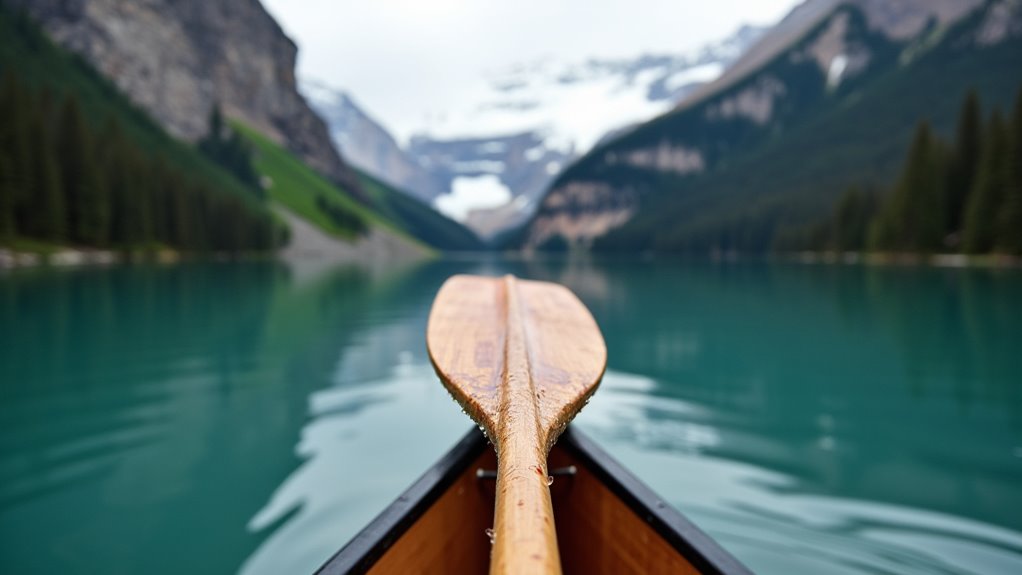
Before you even dip your paddle in the water, you’ll need to choose the right paddle for your body and paddling style. The most important factor is length – your paddle should reach somewhere between your chin and nose when you’re standing next to it upright.
Blade shape matters too. Wide blades give you more power but require more strength, while narrow blades are easier on your arms during long trips.
Material affects both weight and durability. Aluminum paddles are affordable and tough but heavier. Carbon fiber paddles are lightweight and efficient but pricier. Wood offers a nice middle ground with good feel and moderate weight.
Don’t forget grip comfort – you’ll be holding that paddle for hours, so make sure it feels right in your hands. Just like with mountain camping gear, investing in quality equipment that suits your specific needs will make your outdoor adventures much more enjoyable.
Once you’ve got the right paddle in hand, mastering your grip becomes the foundation for every stroke you’ll make on the water. Your top hand should grasp the paddle’s grip with a relaxed but firm hold, positioning your thumb and fingers around the T-grip or knob.
Mastering your paddle grip forms the foundation for every powerful stroke you’ll execute on the water.
Keep this hand directly above the blade for maximum power transfer.
Your bottom hand goes on the shaft, spaced about shoulder-width from your top hand. Don’t grip too tightly – you’ll tire quickly and lose flexibility. Think of holding a bird: firm enough so it won’t fly away, gentle enough not to hurt it.
Switch your grip sides when changing stroke sides, keeping your hands at consistent distances for balanced, efficient paddling throughout your journey. Just like selecting the right camping gear for outdoor adventures, proper grip technique requires careful consideration of comfort and functionality.
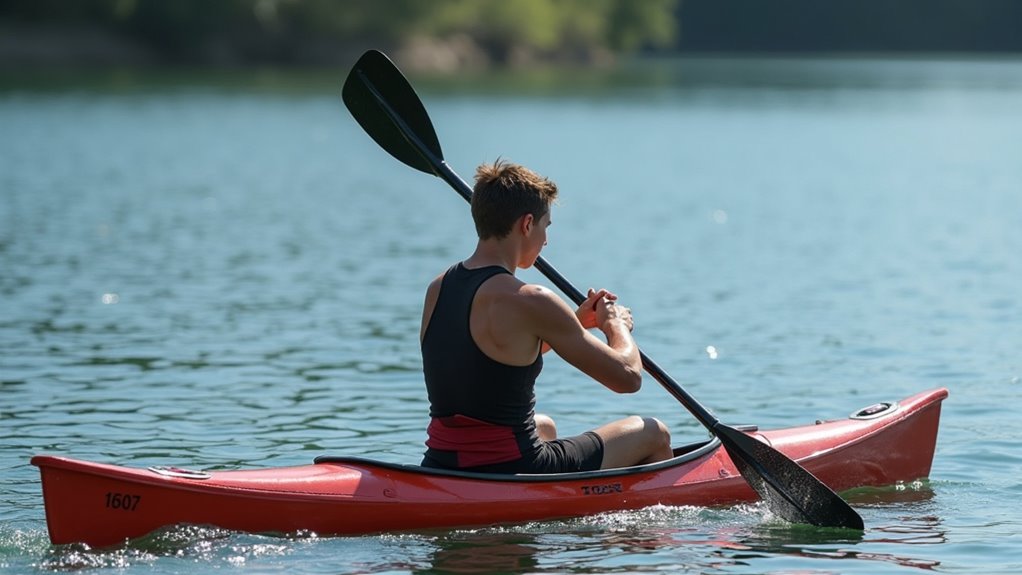
While proper grip sets the foundation for control, your body positioning determines whether you’ll paddle efficiently or fight the water all day. Sit upright with your back straight, not slouched against the seat. Keep your knees slightly bent and feet flat on the canoe’s bottom for stability.
Position yourself so you’re comfortable rotating your torso during each stroke. Your shoulders should stay relaxed, not hunched up toward your ears. When paddling, engage your core muscles – they’re your power source, not just your arms.
Don’t sit too far forward or back in your designated seat area. Center yourself to maintain the canoe’s proper trim. If you’re constantly adjusting your position, you’re wasting energy that should go into forward momentum.
These positioning fundamentals become even more critical when you’re navigating challenging waters during multi-day camping expeditions.
The forward stroke powers your canoe through the water and forms the backbone of every paddling trip. You’ll use this stroke more than any other, so mastering its technique is essential.
Start by reaching forward with your paddle, extending your arms without overreaching. Immerse the blade completely near your feet, keeping it parallel to the canoe’s centerline.
Pull the water toward you using your torso rotation, not just your arms. Your top hand pushes while your bottom hand pulls, creating efficient leverage.
End the stroke when the paddle reaches your hip. Lifting it out later actually slows you down and wastes energy. Keep your strokes smooth and rhythmic rather than rushed.
Practice maintaining consistent paddle placement and timing – this consistency translates directly into better speed and control on the water. Like any skill, avoiding common mistakes while learning the forward stroke will help you develop proper technique from the beginning.
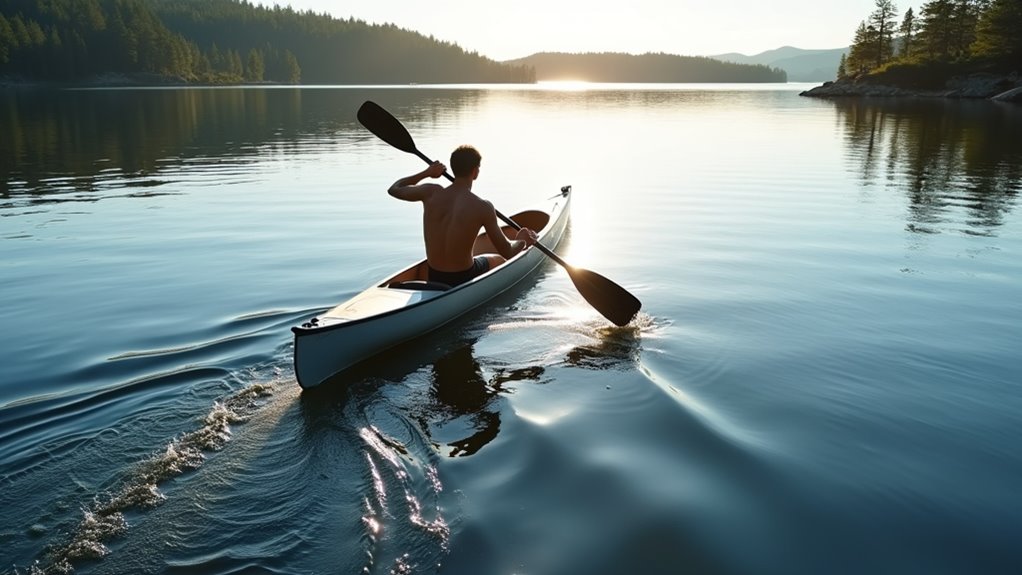
Forward strokes get you moving, but they won’t keep you going straight. Every forward stroke pushes your canoe slightly off course, requiring constant corrections to maintain direction.
Forward strokes create power but sacrifice precision—every paddle stroke naturally veers your canoe sideways, demanding continuous steering adjustments.
The J-stroke is your go-to steering technique. After completing a forward stroke, twist your paddle blade outward at the catch and push it away from the canoe’s hull. This creates a “J” pattern that counteracts the turning force and keeps you tracking straight.
For sharper turns, use sweep strokes. Draw a wide arc from bow to stern, keeping your paddle blade parallel to the water’s surface. A forward sweep on your right turns the canoe left, while a reverse sweep does the opposite.
Practice these techniques until they become second nature – smooth steering makes paddling effortless.
Once you’ve mastered moving forward, you’ll need to learn how to stop and reverse your canoe safely.
To stop quickly, use the brake stroke by placing your paddle vertically in the water alongside the canoe and holding it firmly. The water resistance will slow you down effectively.
For backing up, employ the reverse stroke by pushing water toward the bow instead of pulling it toward the stern. Keep your paddle close to the canoe’s side and use short, controlled strokes.
You can also combine reverse strokes with reverse sweep strokes to back up while turning.
Practice these techniques in calm water before you need them in challenging situations. They’re essential for navigating tight spaces, avoiding obstacles, and docking safely.
These stopping and backing techniques are fundamental skills that every canoe paddler should master early in their learning journey.
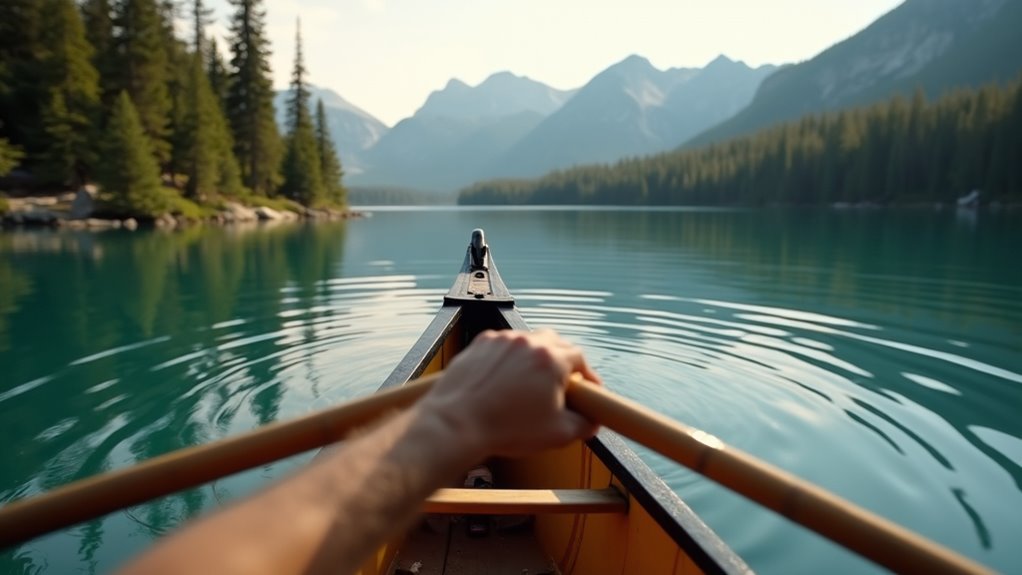
Why do some paddlers look effortlessly graceful while others seem to wobble with every stroke? The secret lies in understanding balance fundamentals. Keep your weight centered and low in the canoe. Sit up straight but relaxed, engaging your core muscles for stability.
Don’t grip the gunwales when you feel unsteady – this actually makes things worse. Instead, trust your paddle as a third point of contact. Keep it in the water whenever possible, using it as a brace.
Your hips should stay loose and responsive to the canoe’s movement. Think of yourself as part of the boat, not fighting against it. Small adjustments work better than dramatic corrections.
Practice shifting your weight gradually while stationary before attempting it while paddling. Balance comes with experience, so be patient with yourself.
When you finally reach shore and set up camp, consider bringing everyone together with some campfire songs to celebrate a successful day on the water.
Water tells a story if you know how to read it. Look for visual clues that reveal what’s happening beneath the surface. Smooth, glassy water indicates deeper areas with minimal current, while ripples and small waves suggest shallower depths or underwater obstacles.
Watch for “V” shapes pointing downstream—these mark the deepest channels where current flows strongest. Conversely, upstream-pointing “V”s warn of rocks or other hazards. Foam lines and debris floating on the surface show current direction and speed.
Pay attention to eddies—circular currents behind large rocks or bends where water actually flows upstream. These provide rest spots and strategic positioning opportunities. Dark water typically means depth, while light-colored water often indicates shallow areas.
You’ll paddle more efficiently and safely when you understand these water signs. Just as selecting the right travel backpacks can make your journey more comfortable, understanding water conditions ensures a smoother paddling experience.
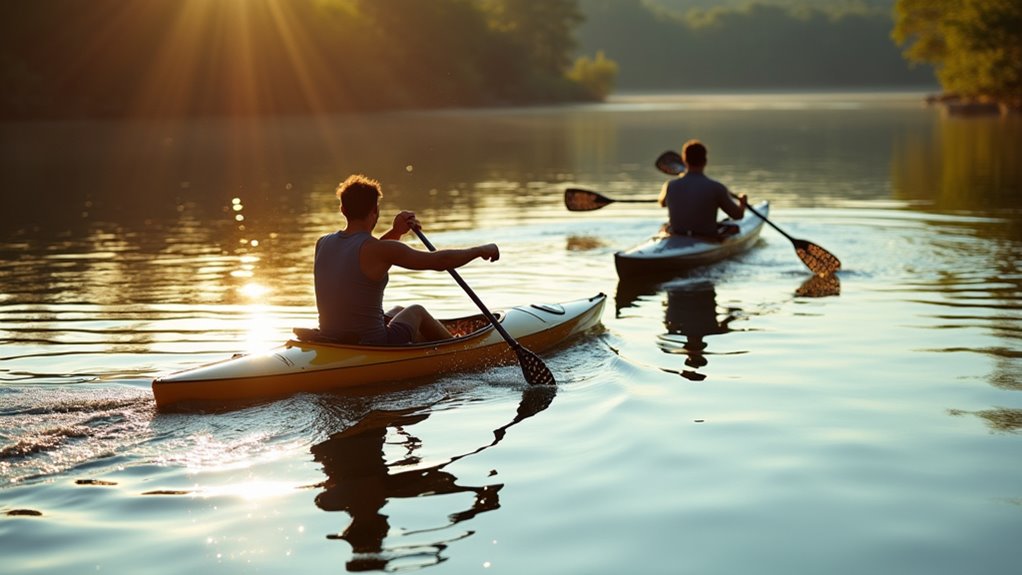
Whether you’re paddling alone or with a partner fundamentally changes how you’ll approach every aspect of canoeing. Solo paddling gives you complete control but demands greater skill and endurance. You’ll switch sides frequently to maintain direction and handle all navigation decisions independently.
Tandem paddling distributes workload between two people, making longer trips more manageable. However, it requires constant communication and synchronized strokes to avoid frustration.
Key differences you’ll encounter:
Choose based on your experience level and trip goals. When planning multi-day canoe trips, having the right sleeping bags can make the difference between a restful night and an uncomfortable experience that affects your paddling performance the next day.
Before you push off from shore, understanding essential safety protocols can mean the difference between a minor mishap and a life-threatening emergency. Always wear your personal flotation device and inform someone about your planned route and return time.
Learn the wet exit technique—how to safely escape if your canoe capsizes. Practice the T-rescue with a partner, where one canoe assists another in emptying water and re-entering.
Master basic self-rescue techniques like swimming your canoe to shallow water while staying upstream of the boat. Carry a whistle, dry bag with essentials, and know hand signals for communication.
Most importantly, don’t paddle beyond your skill level or in conditions that exceed your experience. Your safety depends on preparation and honest self-assessment.
Just as with family camping adventures, proper preparation and safety awareness ensure everyone returns home with positive memories rather than emergency room visits.
You’ll find that mastering these paddling fundamentals coincidentally transforms both your technique and confidence on the water. As you practice proper grip and stroke mechanics, you’ll notice your balance naturally improves at the same moment your reading of water conditions sharpens. It’s no accident that when you focus on body positioning, your steering becomes more precise. Keep practicing these basics—they’ll work together seamlessly, creating the foundation you need for safe, enjoyable paddling adventures ahead.